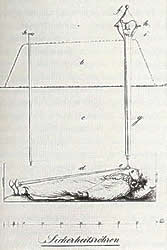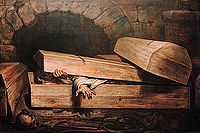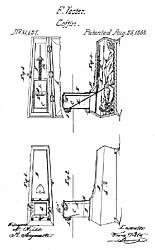
Safety coffin
Encyclopedia

Premature burial
Premature burial, also known as live burial, burial alive, or vivisepulture, means to be buried while still alive. Animals or humans may be buried alive accidentally or intentionally...
or allow the occupant to signal that he/ she has been buried alive. A large number of designs for safety coffins were patented during the 18th and 19th centuries and variations on the idea are still available today.
History
The fear of being buried aliveFear of being buried alive
Fear of being buried alive is the fear of being placed in a grave while still alive as a result of being incorrectly pronounced dead. The abnormal, psychopathological version of this fear is referred to as taphophobia , which is translated as "fear of graves".Before the advent of modern medicine,...
peaked during the cholera
Cholera
Cholera is an infection of the small intestine that is caused by the bacterium Vibrio cholerae. The main symptoms are profuse watery diarrhea and vomiting. Transmission occurs primarily by drinking or eating water or food that has been contaminated by the diarrhea of an infected person or the feces...
epidemics of the 18th and 19th centuries but accounts of live burial have been recorded further back. When his tomb was reopened, the philosopher John Duns Scotus
Duns Scotus
Blessed John Duns Scotus, O.F.M. was one of the more important theologians and philosophers of the High Middle Ages. He was nicknamed Doctor Subtilis for his penetrating and subtle manner of thought....
(1266 – 1308) was reportedly found outside his coffin with his hands torn and bloody after attempting to escape. The fears of being buried alive were heightened by reports of doctors and accounts in literature and the newspapers. As well as dealing with the subject in "The Fall of the House of Usher
The Fall of the House of Usher
"The Fall of the House of Usher" is a short story by Edgar Allan Poe, first published in September 1839 in Burton's Gentleman's Magazine. It was slightly revised in 1840 for the collection Tales of the Grotesque and Arabesque...
" and "The Cask of Amontillado
The Cask of Amontillado
"The Cask of Amontillado" is a short story by Edgar Allan Poe, first published in the November 1846 issue of Godey's Lady's Book....
", Edgar Allan Poe
Edgar Allan Poe
Edgar Allan Poe was an American author, poet, editor and literary critic, considered part of the American Romantic Movement. Best known for his tales of mystery and the macabre, Poe was one of the earliest American practitioners of the short story and is considered the inventor of the detective...
wrote "The Premature Burial
The Premature Burial
"The Premature Burial" is a horror short story on the theme of being buried alive, written by Edgar Allan Poe and published in 1844 in The Philadelphia Dollar Newspaper. Fear of being buried alive was common in this period and Poe was taking advantage of the public interest...
", which was published in 1844. It contained accounts of supposedly genuine cases of premature burial as well as detailing the narrator's own (perceived) interment while still alive.

The First Great Train Robbery
The First Great Train Robbery — known in the U.S. as The Great Train Robbery — is a 1979 film directed by Michael Crichton, who also wrote the screenplay based on his novel The Great Train Robbery...
. Other variations on the bell included flags and pyrotechnics. Some designs included ladders, escape hatches, and even feeding tubes, but many forgot a method for providing air.
The first recorded safety coffin was constructed on the orders of Duke Ferdinand of Brunswick
Duke Ferdinand of Brunswick
Ferdinand, Prince of Brunswick-Lüneburg , was a Prussian field marshal known for his participation in the Seven Years' War...
before his death in 1792. He had a window installed to allow light in, an air tube to provide a supply of fresh air, and instead of having the lid nailed down he had a lock fitted. In a special pocket of his shroud he had two keys, one for the coffin lid and a second for the tomb door.
P.G. Pessler, a German priest, suggested in 1798 that all coffins have a tube inserted from which a cord would run to the church bells. If an individual had been buried alive he could draw attention to himself by ringing the bells. This idea, while highly impractical, led to the first designs of safety coffins equipped with signalling systems. Pessler's colleague, Pastor Beck, suggested that coffins should have a small trumpet-like tube attached. Each day the local priest could check the state of putrefaction of the corpse by sniffing the odours emanating from the tube. If no odour was detected or the priest heard cries for help the coffin could be dug up and the occupant rescued.
Dr Adolf Gutsmuth was buried alive several times to demonstrate a safety coffin of his own design, and in 1822 he stayed underground for several hours and even ate a meal of soup, sausages and beer delivered to him through the coffin's feeding tube.
The 1820s also saw the use of "portable death chambers" in Germany. A small chamber, equipped with a bell for signalling and a window for viewing the body, was constructed over an empty grave. Watchmen would check each day for signs of life or decomposition in each of the chambers. If the bell was rung the body could be immediately removed, but if the watchman observed signs of putrefaction in the corpse, a door in the floor of the chamber could be opened and the body would drop down into the grave. A panel could then be slid in to cover the grave and the upper chamber removed and reused.
In 1829, Dr Johann Gottfried Taberger designed a system using a bell which would alert the cemetery nightwatchman
Security guard
A security guard is a person who is paid to protect property, assets, or people. Security guards are usually privately and formally employed personnel...
. The corpse would have strings attached to its hands, head and feet. A housing around the bell above ground prevented it ringing accidentally. An improvement over previous designs, the housing prevented rain water from running down the tube and netting prevented insects entering the coffin. If the bell rang the watchman had to insert a second tube and pump air into the coffin with a bellows
Bellows
A bellows is a device for delivering pressurized air in a controlled quantity to a controlled location.Basically, a bellows is a deformable container which has an outlet nozzle. When the volume of the bellows is decreased, the air escapes through the outlet...
to allow the occupant to survive until the casket could be dug up.

Count Michel de Karnice-Karnicki, a chamberlain to the Tsar of Russia
Nicholas II of Russia
Nicholas II was the last Emperor of Russia, Grand Prince of Finland, and titular King of Poland. His official short title was Nicholas II, Emperor and Autocrat of All the Russias and he is known as Saint Nicholas the Passion-Bearer by the Russian Orthodox Church.Nicholas II ruled from 1894 until...
, patented his own safety coffin, called Le Karnice, in 1897 and demonstrated it at the Sorbonne
Sorbonne
The Sorbonne is an edifice of the Latin Quarter, in Paris, France, which has been the historical house of the former University of Paris...
the following year. His design detected movement in the coffin and opened a tube to supply air while simultaneously raising a flag and ringing a bell. Le Karnice never caught on: it was too sensitive to allow for even a slight movement in a decaying corpse, and a demonstration in which one of Karnice-Karnicki's assistants had been buried alive ended badly when the signalling systems failed. Luckily, the breathing tube had activated and the assistant was disinterred unharmed, but the reputation of Le Karnice was damaged beyond repair.
In 1995 a modern safety coffin was patented by Fabrizio Caselli. His design included an emergency alarm, intercom
Intercom
An intercom , talkback or doorphone is a stand-alone voice communications system for use within a building or small collection of buildings, functioning independently of the public telephone network. Intercoms are generally mounted permanently in buildings and vehicles...
system, a torch (flashlight), breathing apparatus, and both a heart monitor and stimulator.
Despite the fear of burial while still alive, there are no documented cases of anybody being saved by a safety coffin.
Saved by the Bell
Folk etymology states that the phrases "saved by the bell", "dead ringer" and "graveyard shiftGraveyard shift
A graveyard shift means a shift of work running through the early hours of the morning, especially one from midnight until 8 am. See shift work.Graveyard shift may also refer to:In movies, television, and video games:...
" come from the use of safety coffins in the Victorian era. Neither etymology is true - the phrase "saved by the bell" comes from boxing and "graveyard shift" and "dead ringer" both date from the twentieth century.
See also
- Burial vaultBurial vault (enclosure)A burial vault is a sturdy box designed to protect the coffin inside of it. The body is placed within the coffin, which is then placed inside the vault. Body, coffin, and vault are buried. A burial vault serves as an outer enclosure for buried remains; the coffin serves as an inner enclosure.Vaults...
- Lazarus phenomenon
- TombTombA tomb is a repository for the remains of the dead. It is generally any structurally enclosed interment space or burial chamber, of varying sizes...

